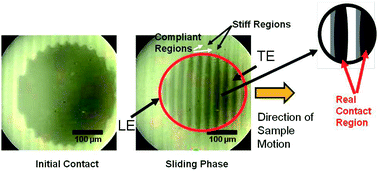We show that significant reduction of sliding friction can be achieved between a rigid surface and a flat elastic surface by spatial variation in stiffness of the latter. This reduction in friction during sliding occurs due to an “auto-roughening” phenomenon in which a fully connected contact region breaks into partial contact. An elastomer, poly(dimethylsiloxane) (PDMS), was used to fabricate nominally flat surfaces with regions of two different stiffness, achieved by using two different concentrations of the cross-linker. Both experiments and finite element simulation show that, for sufficiently high friction and low normal load, the real contact area between a rigid indenter and a surface with spatially varying stiffness is reduced significantly due to auto-roughening. The finite element model also shows how the auto-roughening depends on the properties and geometry of interfacial structures, resulting in reduced overall friction.
